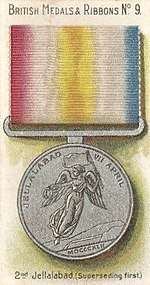Jellalabad Medals
The Jellalabad Medal, a campaign medal issued by the British East India Company. It was established by George Eden, the Governor-General of India, on 30 April 1842.
The medal was awarded for the defence of Jalalabad from 12 November 1841 to 7 April 1842, during the First Afghan War, to the troops under the command of Sir Robert Sale.[1] About 2,600 soldiers took part, including the 13th Foot (the only British Army unit present), the 35th Bengal Native Infantry, as well as detachments from other Indian Army units and some loyal Afghan forces.[2]
| Jellalabad Medal | |
|---|---|
  Left: Obverse, first type. Right: Reverse, second type | |
| Awarded by | |
| Country | |
| Type | Campaign Medal |
| Campaign(s) | First Anglo-Afghan War |
| Clasps | None |
| Statistics | |
| Established | 30 April 1842 |
| Total awarded | 2,654 |
Ribbon bar of the medal | |
Appearance
Two different versions of the Jellalabad Medal were awarded.[3]
The original medal was produced by the Calcutta Mint. It is silver and 39 millimetres (1.5 in) in diameter.[4]
Obverse: A mural crown with 'JELLALABAD' above.
Reverse: The date 'VII APRIL 1842' over three lines.
Suspension: A straight steel suspender attached to the medal by way of a steel clip. This original suspension was often replaced by a more decorative version.
Naming: Issued unnamed, the medal was often named privately. The medals awarded to the 13th Foot had the name and regiment of the recipient engraved at their commanding officer's expense.
This version was considered inartistic and, although awarded to serving soldiers, insufficient were produced to issue to next of kin of those who had died during the campaign. The East India Company therefore decided to strike a further issue of a new design. Although those in receipt of the original medal could exchange for the new medal, few did so with, for example, only five men of the 13th Foot opting to exchange.[4]
The second version of the medal was designed by William Wyon and produced by the Royal Mint in London. It is silver and 36 millimetres (1.4 in) in diameter.[4]
Obverse: The diademed head Queen Victoria facing left with the inscription 'VICTORIA VINDEX' (PROTECTOR).[5]
Reverse: a winged figure of Victory flying over the fortress at Jellalabad. Above is the inscription 'JELLALABAD VII APRIL' with below the year 'MDCCCXLII'.
Suspension: A straight suspender attached to the medal by way of a steel clip. Many recipients replaced this with a more ornate silver suspension.
Naming: The recipient's name and regiment were impressed on the edge in block capitals.
The ribbon of both versions was a rainbow pattern of red, white, yellow, white and blue.[6]
No clasp was awarded with either medal.[4]
Anglo-Afghan War
Four separate campaign medals were awarded to British led forces who served in the Afghan War of 1839 to 1842:[7]
- Ghuznee Medal. Storming of Ghuznee fortress, 21–23 July 1839.
- Jellalabad Medal. Defence of Jalalabad, 12 November 1841 – 7 April 1842.
- Medal for the Defence of Kelat-I-Ghilzie. Defence of Kelat-I-Ghilzie, January–26 May 1842.
- Candahar, Ghuznee, Cabul Medal. Major operations of 1842, the final year of the war.
References
- "Jellalabad Medal (1st issue), awarded to Pvt. Joseph Walker, 1842". Watson Medals Catalogue. The Fitzwilliam Museum. Retrieved 18 March 2011.
- D.W Collett. Medals Yearbook, 1981. p. 68. 1981.
- John Mussell (ed). Medal Yearbook 2015. p. 138. Token Publishing Ltd. Honiton, Devon.
- Joslin, Litherland and Simpkin. British Battles and Medals. p. 108. Published Spink, London. 1988.
- Cassell's New Latin-English Dictionary, 5th edition 1968. p. 643. ISBN 0304929093. Defines Vindex as: 'one who lays claim to or protects, a claimant or protector'
- Joslin, Litherland and Simpkin. British Battles and Medals. p. 272 ribbon chart. Published Spink, London. 1988.
- Edward C. Joslin. Observer's Book of British Awards and Medals. p. 90. Published Frederick Warne & Co, London. 1974.